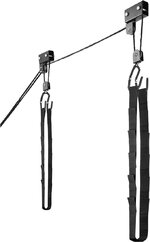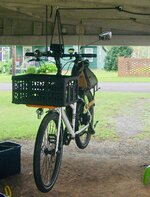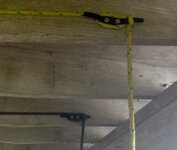My preferred assistant to work on my bike.
Straps are much easier and more versatile than hooks alone.
I've been using ropes with 650-pound eye bolts. There's more friction than using pulleys, but that's okay. I lift and secure one end at a time, so I can lift with one hand and pull the rope with the other. Rope friction becomes an asset, making it easy to keep the bike from falling.
Until a couple of days ago, I was using one eye bolt for each end. One photo shows a bike suspended that way. It's a good setup for adjusting a derailleur with a laser lavel. With the bars suspended that way, the rope will slide to equalize when I move the bars to plumb the bike. Then rope friction will keep it plumb, ready for me to shine a vertical laser beam on the derailleur from behind. Evan a little swinging interferes with a task like that, but it wasn't bad. I guess rope friction dampened the oscillations.
Swinging hadn't been a problem so far, but another photo shows how I used two eye bolts on each end to experiment with stiffening it against swinging. The V of the yellow rope prevents the stem from moving laterally, but maybe the bike could swing below the stem. The rear carrier is suspended by the brown rope in an X threading, which stiffens the bike against swinging independently of the rope.
Two hassles were running a long rope through the path I needed, and tying off the end, which could be pretty long. Today I installed cleats. I pile the rope below the cleat, take the end up and over the cleat, run it through the first eye bolt, and thread it where I need it with no excess rope in my way. To tie off after lifting, one hand can make a foolproof knot around a horn of the cleat, with the bight of the rope.
I like to use a portable work table for bike repairs. It's at a good height and has pockets to keep small parts from being knocked off. It occurred to me that this could be used to keep a suspended bike from swinging: push the table against the bike, or lash the bike to it. With the leaves folded down, it's a saw horse. Here I am weighing it. 23.8 pounds. That should keep a bike from swinging.






